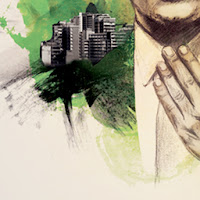A part of Tom is that he wears glasses to see to his best ability.
Myself experimenting with glasses explained to me that the aid short sighted or long sighted visual impairments.
I have generated various experiments which focus around vision, blurred vision and blurriness.
This experiment created on photoshop revolves around layering the images and changing each of the most forward layer to a slightly lighter tone which creates an effect of the word travelling into the background. I feel to an extent this could reflect visual impairment but more so inebriation.
Here I have created multiple experiments by adjusting the spacing between the lines of a sentence.
As each lines comes closer to the other and they merge into one, it can become quite baffling on the brain, and create a typeface of it's own, which makes use of many lines and bowls of the letters.
I chose to use a range of adjustable levels when editing the spacing as each quantity had a more rational/irrational effect.
This is an idea that I could carry forward as it does make a very aesthetically pleasing looking typeface, and I find it quite inventive.
These 4 different experiments are a result of using Photoshop's blur tool on a rasterized layer of Tom's name. I love how the lines curve and bend, this adds a certain personality to the font alone. Again, this result is similar to the effects of inebriation on the eye, although I do feel it looks very unique and creative.






























